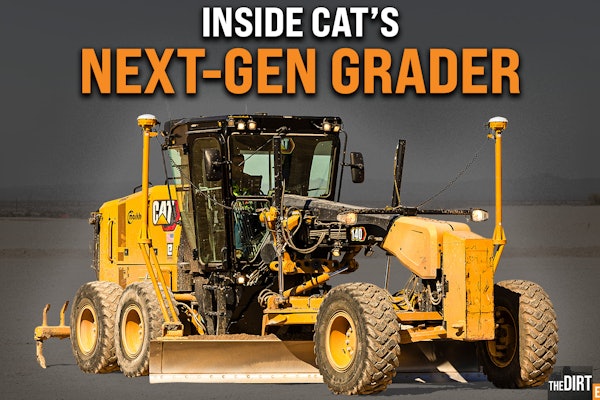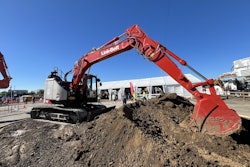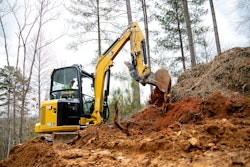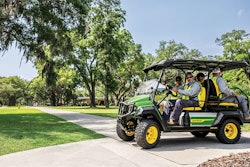Unlike many pieces of equipment that are turned every few years, a vibratory roller is simple and sturdy enough to repair and rebuild almost indefinitely. But as with any machine, the cost and frequency of repairs increases as a roller ages. For that reason, contractors who need high rates of machine availability will buy new and then unload their rollers every three to four years. But for contractors who do lower volumes of work, the uncomplicated nature of these machines make them good candidates for years of service.
“Rollers don’t consume a lot of parts,” says Brodie Hutchins, marketing manager for road development aftermarket products at Ingersoll-Rand. “I’ve seen companies with good maintenance practices keep the same rollers for 10 years or more.”
No water, no work
“The single biggest area that people experience day-to-day trouble with is the water system,” says Ron Cosper, customer service manager for Holt Cat in San Antonio, Texas. When the water tanks are filled with cloudy or dirty water, the filters become clogged and sediment shuts down one or more of the spray nozzles on the spray bar. Then the dry spot on the drum starts picking up asphalt off the mat and suddenly you’ve got asphalt to repair and machine maintenance in the field.
The health of the spray system filters is particularly critical in remote areas where crews are bringing in river water or agricultural water to fill the tanks, Cosper says.
One bad practice operators sometimes perform in the field is taking the strainer out of the top of the water tank before filling it, Hutchins says. This allows them to stick the hose in the tank and walk away, but the strainer is the first line of defense against leaves and other large debris.
Healthy hydraulics make everything go better, last longer
In smaller rollers one hydraulic pump may run both the vibratory system and the drive system. Larger rollers will have two separate pumps. Best practices and lifecycle issues are the same except the longevity of the pump for the vibration system depends on how frequently it is used.
“In studies that we have done, we have the vibratory system used as little as 20 percent of the time and up to 80 percent,” says Wes Steffan, product specialist at Caterpillar Paving. “Start and stop cycles play a big role here as well.”
The health of the vibratory mechanism is heavily dependent on the health and maintenance of the hydraulic system that powers it. Overheated hydraulic fluid can degrade hoses and seals and may result in unplanned shutdown. Plus changing a hose in the field greatly increases the risk of contamination.
The best way to prevent these problems, Steffan says, is to regularly inspect and change any marginal hoses in a clean shop environment. Also keep a close watch on the condition and level of your hydraulic fluid and the overall condition of your hydraulic oil cooler. When changing or adding hydraulic fluids, a good practice to follow is to filter the replacement fluid at the point of fill. The cleaner fluid will lengthen the life of the hydraulic charge filter and components.
The vibratory bearing reservoir/seals have the same lifecycle as the hydraulics for the vibratory system, Steffan says. Most vibratory bearings today use synthetic oils. This combined with initial component cleanliness during assembly allows the oil change interval to go as long as three years or 3,000 hours.
Engines require regular checkups
The longevity of your engine depends on how hard you work it and how well you maintain it. The best way to gauge how hard you’re working it is to monitor how much diesel it burns relative to the maximum possible fuel consumption. The fuel burn rate is also sometimes referred to as the duty cycle or percent of horsepower used.
The steady nature of the work done by asphalt rollers means there is little deviation from the preset engine rpm. “About the only time these engines see much stress is when they’re climbing a long hill or when the vibration system is engaged and disengaged,” Hutchins says.
According to Steffan, good maintenance practices and scheduled oil sampling can help pinpoint engine problems early. Air filter indicators let you know when it’s time to change air filters. Other filters should be changed according to the manufacturers’ recommendations. Some manufacturers are now offering extended oil change intervals (500 hours) to reduce maintenance costs, but this should be accompanied by regular oil sampling. When fuel filters are changed, Steffan recommends you don’t fill them prior to installing them. “The unfiltered fuel will shorten fuel component life,” he says.
Hutchins advises roller owners to change oils as specified in the maintenance schedule even if the machine hasn’t reached its hour limit for oil changes. “As fluids age, acids build up, even if you are not using the machine,” he says. “It goes sour, like milk.”
A lot hangs on the articulation joint
This assembly carries an enormous amount of weight, but will typically last the life of the machine unless it gets damaged through operator error, such as rolling the machine over a curb or dropping it off the trailer. Typical maintenance is weekly greasing of the articulation and oscillation bearings although many manufacturers are moving toward a maintenance-free articulation joint.
One way to tell if your articulation joint is headed for failure is to visually inspect it for stress cracks around the weldments, Hutchins says. Greasing the articulation joint is another frequently overlooked task.
Drums do wear out eventually
These usually last the life of the machine unless damaged accidentally. If you hit something hard enough, or load or unload a roller carelessly, you can put a flat spot on the drum, Hutchins says. Drums also wear out prematurely from misapplication or over compaction.
Normal wear will eventually thin out the drums or cause them to go out of round. Double-vibratory drums are used frequently on base materials, which is more abrasive than asphalt. But drum replacement is fairly straightforward and done frequently when rollers are being rebuilt for a second lifecycle.
The eccentric bearings are also a good candidate for replacement when the drums are being replaced.
Isolation mounts key for damping vibration
Small but important, the isolation mounts should be replaced on an as-needed basis, but before failure. One failure leads to overloading and premature failure of the remaining mounts. From the moment you start using them, vibratory rollers are trying to shake themselves apart, Hutchins says.
Equipment designers go to great lengths to harmonically tune the machines to prevent destructive vibrations from traveling from the drums through the rest of the machine, says George Platt, marketing manager for Dynapac. “But when you induce vibration in a piece of equipment you create a wear situation that is not always as predictable as you would like it to be,” he says.
The isolation mounts are your first line of defense against this. Visually inspect these for cracks or damage to the rubber.









